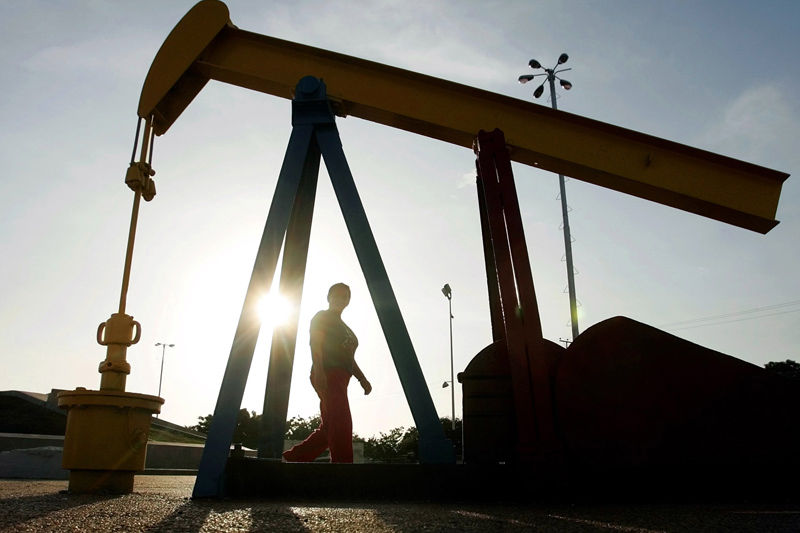Investing.com - Crude oil futures were modestly lower during European morning trade on Thursday, as Wednesday’s disappointing economic reports from the U.S. and the euro zone continued to weigh on sentiment, while investors eyed the outcome of a European Central Bank policy-setting meeting later in the day.
On the New York Mercantile Exchange, light sweet crude futures for delivery in June traded at USD105.01 a barrel during European morning trade, dipping 0.2%.
It earlier fell by as much as 0.5% to trade at a two-day low of USD104.86 a barrel.
Oil traders were eyeing the outcome of the ECB rate-meeting and a subsequent press conference with ECB head Mario Draghi, amid ongoing concerns over elevated borrowing costs for vulnerable peripheral nations, particularly Spain.
Investors were widely expecting the ECB to leave rates on hold, but will search for clues in regards to the central bank's next course of action in dealing with an ongoing sovereign debt crisis.
Markets were also awaiting a government bond auction by Spain, the first since its most recent downgrade.
Sentiment was sharply hit on Wednesday after a string of weak data from the euro zone and the U.S. reignited fears over the outlook for global economic growth.
In the euro zone, reports showed that the unemployment rate in the single currency bloc climbed to a record 10.7% in March and final euro zone manufacturing data for April slumped to a 34-month low.
The euro zone accounted for nearly 12% of global oil consumption in 2010, according to data from British Petroleum.
There are worries that the region’s sovereign debt crisis could trigger a broader economic slowdown that would curb demand for oil.
Meanwhile, data from payroll processing firm ADP showed that the U.S. private sector added 119,000 jobs in April, far short of expectations for a gain of 177,000, after an increase of 209,000 in March. It was the smallest increase in ADP nonfarm payrolls since September 2011.
The data added to fears that the economic recovery in the U.S. is losing momentum, ahead of a government report on nonfarm payrolls on Friday, after government data in March showed a slowdown in hiring.
Oil traders have long been taking cues from the monthly jobs report, the most-closely followed indicator of U.S. employment, because it offers insight into the economic health of the world's biggest oil consumer.
Meanwhile, a larger-than-expected build in U.S. oil supplies last week is forcing traders to refocus on the supply and demand picture.
The U.S. Energy Department said in its weekly report that crude oil inventories rose by 2.84 million barrels last week to a total of 375.9 million, the highest level since September 1990, underscoring fears over a slowdown in oil demand from the U.S.
The U.S. is the world’s biggest oil-consuming country, responsible for almost 22% of global oil demand.
Elsewhere, on the ICE Futures Exchange, Brent oil futures for June delivery was flat, trading at 118.20 a barrel, with the spread between the Brent and crude contracts standing at USD13.19.
The spread between the two crudes dropped to USD12.98 yesterday, the smallest difference in more than three months.
On the New York Mercantile Exchange, light sweet crude futures for delivery in June traded at USD105.01 a barrel during European morning trade, dipping 0.2%.
It earlier fell by as much as 0.5% to trade at a two-day low of USD104.86 a barrel.
Oil traders were eyeing the outcome of the ECB rate-meeting and a subsequent press conference with ECB head Mario Draghi, amid ongoing concerns over elevated borrowing costs for vulnerable peripheral nations, particularly Spain.
Investors were widely expecting the ECB to leave rates on hold, but will search for clues in regards to the central bank's next course of action in dealing with an ongoing sovereign debt crisis.
Markets were also awaiting a government bond auction by Spain, the first since its most recent downgrade.
Sentiment was sharply hit on Wednesday after a string of weak data from the euro zone and the U.S. reignited fears over the outlook for global economic growth.
In the euro zone, reports showed that the unemployment rate in the single currency bloc climbed to a record 10.7% in March and final euro zone manufacturing data for April slumped to a 34-month low.
The euro zone accounted for nearly 12% of global oil consumption in 2010, according to data from British Petroleum.
There are worries that the region’s sovereign debt crisis could trigger a broader economic slowdown that would curb demand for oil.
Meanwhile, data from payroll processing firm ADP showed that the U.S. private sector added 119,000 jobs in April, far short of expectations for a gain of 177,000, after an increase of 209,000 in March. It was the smallest increase in ADP nonfarm payrolls since September 2011.
The data added to fears that the economic recovery in the U.S. is losing momentum, ahead of a government report on nonfarm payrolls on Friday, after government data in March showed a slowdown in hiring.
Oil traders have long been taking cues from the monthly jobs report, the most-closely followed indicator of U.S. employment, because it offers insight into the economic health of the world's biggest oil consumer.
Meanwhile, a larger-than-expected build in U.S. oil supplies last week is forcing traders to refocus on the supply and demand picture.
The U.S. Energy Department said in its weekly report that crude oil inventories rose by 2.84 million barrels last week to a total of 375.9 million, the highest level since September 1990, underscoring fears over a slowdown in oil demand from the U.S.
The U.S. is the world’s biggest oil-consuming country, responsible for almost 22% of global oil demand.
Elsewhere, on the ICE Futures Exchange, Brent oil futures for June delivery was flat, trading at 118.20 a barrel, with the spread between the Brent and crude contracts standing at USD13.19.
The spread between the two crudes dropped to USD12.98 yesterday, the smallest difference in more than three months.
